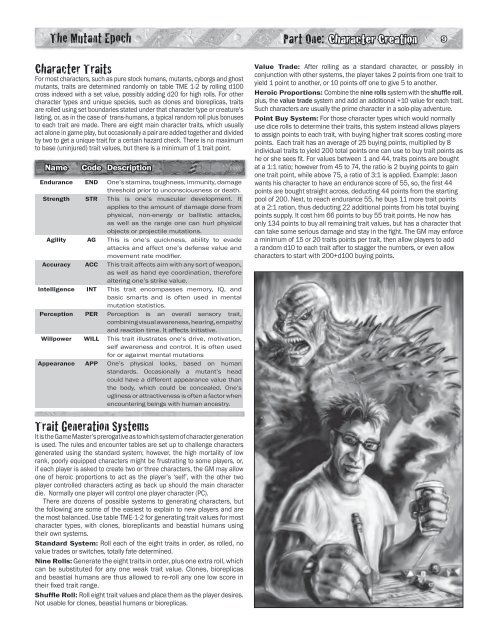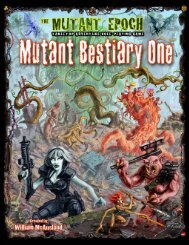The-Mutant-Epoch-RPG-Hub-Rules-DEMO
The-Mutant-Epoch-RPG-Hub-Rules-DEMO
The-Mutant-Epoch-RPG-Hub-Rules-DEMO
You also want an ePaper? Increase the reach of your titles
YUMPU automatically turns print PDFs into web optimized ePapers that Google loves.
<strong>The</strong> <strong>The</strong> <strong>Mutant</strong> <strong>Mutant</strong> <strong>Epoch</strong> <strong>Epoch</strong> Part One: Character Introduction Creation Character TraitsFor most characters, such as pure stock humans, mutants, cyborgs and ghostmutants, traits are determined randomly on table TME 1-2 by rolling d100cross indexed with a set value, possibly adding d20 for high rolls. For othercharacter types and unique species, such as clones and bioreplicas, traitsare rolled using set boundaries stated under that character type or creature’slisting, or, as in the case of trans-humans, a typical random roll plus bonusesto each trait are made. <strong>The</strong>re are eight main character traits, which usuallyact alone in game play, but occasionally a pair are added together and dividedby two to get a unique trait for a certain hazard check. <strong>The</strong>re is no maximumto base (uninjured) trait values, but there is a minimum of 1 trait point.NameCode DescriptionEndurance END One’s stamina, toughness, immunity, damagethreshold prior to unconsciousness or death.Strength STR This is one’s muscular development. Itapplies to the amount of damage done fromphysical, non-energy or ballistic attacks,as well as the range one can hurl physicalobjects or projectile mutations.Agility AG This is one’s quickness, ability to evadeattacks and affect one’s defense value andmovement rate modifier.Accuracy ACC This trait affects aim with any sort of weapon,as well as hand eye coordination, thereforealtering one’s strike value.Intelligence INT This trait encompasses memory, IQ, andbasic smarts and is often used in mentalmutation statistics.Perception PER Perception is an overall sensory trait,combining visual awareness, hearing, empathyand reaction time. It affects initiative.Willpower WILL This trait illustrates one’s drive, motivation,self awareness and control. It is often usedfor or against mental mutationsAppearance APP One’s physical looks, based on humanstandards. Occasionally a mutant’s headcould have a different appearance value thanthe body, which could be concealed. One’sugliness or attractiveness is often a factor whenencountering beings with human ancestry.Value Trade: After rolling as a standard character, or possibly inconjunction with other systems, the player takes 2 points from one trait toyield 1 point to another, or 10 points off one to give 5 to another.Heroic Proportions: Combine the nine rolls system with the shuffle roll,plus, the value trade system and add an additional +10 value for each trait.Such characters are usually the prime character in a solo-play adventure.Point Buy System: For those character types which would normallyuse dice rolls to determine their traits, this system instead allows playersto assign points to each trait, with buying higher trait scores costing morepoints. Each trait has an average of 25 buying points, multiplied by 8individual traits to yield 200 total points one can use to buy trait points ashe or she sees fit. For values between 1 and 44, traits points are boughtat a 1:1 ratio; however from 45 to 74, the ratio is 2 buying points to gainone trait point, while above 75, a ratio of 3:1 is applied. Example: Jasonwants his character to have an endurance score of 55, so, the first 44points are bought straight across, deducting 44 points from the startingpool of 200. Next, to reach endurance 55, he buys 11 more trait pointsat a 2:1 ration, thus deducting 22 additional points from his total buyingpoints supply. It cost him 66 points to buy 55 trait points. He now hasonly 134 points to buy all remaining trait values, but has a character thatcan take some serious damage and stay in the fight. <strong>The</strong> GM may enforcea minimum of 15 or 20 traits points per trait, then allow players to adda random d10 to each trait after to stagger the numbers, or even allowcharacters to start with 200+d100 buying points.Trait Generation SystemsIt is the Game Master’s prerogative as to which system of character generationis used. <strong>The</strong> rules and encounter tables are set up to challenge charactersgenerated using the standard system; however, the high mortality of lowrank, poorly equipped characters might be frustrating to some players, or,if each player is asked to create two or three characters, the GM may allowone of heroic proportions to act as the player’s ‘self’, with the other twoplayer controlled characters acting as back up should the main characterdie. Normally one player will control one player character (PC).<strong>The</strong>re are dozens of possible systems to generating characters, butthe following are some of the easiest to explain to new players and arethe most balanced. Use table TME-1-2 for generating trait values for mostcharacter types, with clones, bioreplicants and beastial humans usingtheir own systems.Standard System: Roll each of the eight traits in order, as rolled, novalue trades or switches, totally fate determined.Nine Rolls: Generate the eight traits in order, plus one extra roll, whichcan be substituted for any one weak trait value. Clones, bioreplicasand beastial humans are thus allowed to re-roll any one low score intheir fixed trait range.Shuffle Roll: Roll eight trait values and place them as the player desires.Not usable for clones, beastial humans or bioreplicas.



